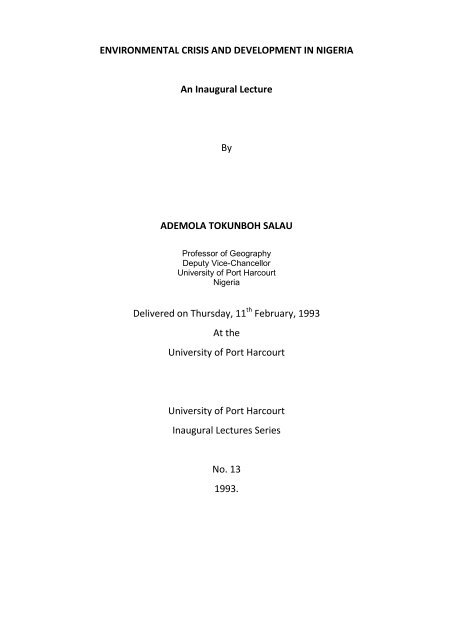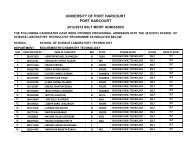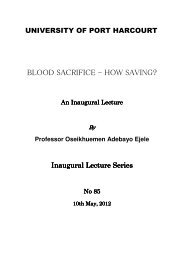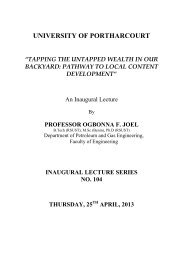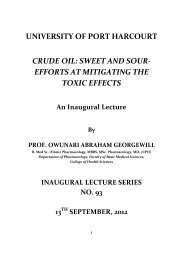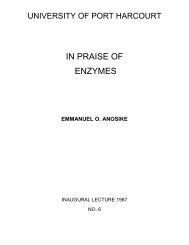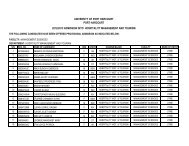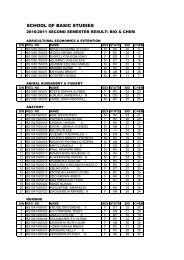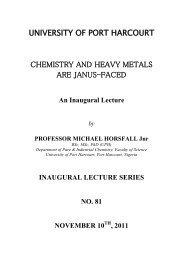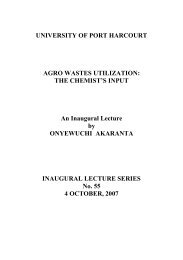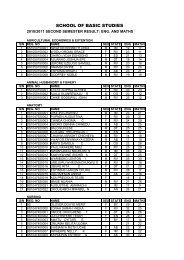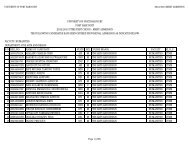13th Inaugural Lecture - 1993 by Prof. Ademola T Salau
13th Inaugural Lecture - 1993 by Prof. Ademola T Salau
13th Inaugural Lecture - 1993 by Prof. Ademola T Salau
- No tags were found...
You also want an ePaper? Increase the reach of your titles
YUMPU automatically turns print PDFs into web optimized ePapers that Google loves.
ENVIRONMENTAL CRISIS AND DEVELOPMENT IN NIGERIAAn <strong>Inaugural</strong> <strong>Lecture</strong>ByADEMOLA TOKUNBOH SALAU<strong>Prof</strong>essor of GeographyDeputy Vice-ChancellorUniversity of Port HarcourtNigeriaDelivered on Thursday, 11 th February, <strong>1993</strong>At theUniversity of Port HarcourtUniversity of Port Harcourt<strong>Inaugural</strong> <strong>Lecture</strong>s SeriesNo. 13<strong>1993</strong>.
DEDICATIONThis lecture is dedicated to Eme Ekekwe and the 25 men and women whogathered on 17 th July, 1987 at a meeting in Ibadan which gave birth to anenvironmental pressure group called NEST (NIGERIAN ENVIRONMENTALSTUDY/ACTION TEAM).ANDTO A GREENER AND GREATER NIGERIA
Vice-ChancellorRegistrar and other Principal Officers of the UniversityDeans of Faculties and Provost, College of Health Sciences<strong>Prof</strong>essors and Heads of DepartmentsDistinguished Ladies and GentlemenIt is indeed a great honour for me to stand here before you this evening topresent the first inaugural lecture emanating from the Faculty of SocialSciences. It is also with a deep sense of humility that I represent this facultywhich has contributed in a major way to the high reputation being enjoyed <strong>by</strong>this citadel of learning, this “Unique Uniport” today.The Faculty of Social Sciences is indeed very proud that its Foundation Dean,<strong>Prof</strong>essor Claude Ake, is the second National Merit Award Winner from thisUniversity. His successor as Dean, equally a giant scholar, was <strong>Prof</strong>essor IkennaNzimiro, a member of the Presidential Advisory Committee for the past sevenyears. For those who may be unaware of this fact, the Orchards at theUniversity Park are the handiworks of another former Dean of ours, a humaneand brilliant man of letters in the person of <strong>Prof</strong>essor K.L.S Kodjo. <strong>Prof</strong>essorKodjo who is now the Dean of the Faculty Sciences Economiques et SciencesGestion at the Universite du Benin, Lome, Togo; devoted almost two decadesof his life to the upliftment of higher education in Nigeria (first at theUniversity of Nigeria and then at this University). Of course, the present Dean,<strong>Prof</strong>essor Olatunde Ojo left the comfort of the University of Ife (now calledObafemi Awolowo University) to join <strong>Prof</strong>essor Donald Ekong (the first Vice-Chancellor) in building a new University. His invaluable contribution as the firstDean of Student Affairs and Director of Studies (Political Science) needs noembellishment. I salute all these men.The first dilemma facing an inaugural lecturer is the choice of a topic. It iscustomary that the chosen topic highlights a particular problem in which the
discipline to which the lecturer belongs has contributed towards resolving.The second problem relates to the need to present the lecture in a less arcanelanguage. It is not always easy to resolve these problems. During mypreparation for this lecture, I read many inaugural lectures previouslydelivered in some Nigerian Universities. One cannot but be impressed with theingenuity of some lecturers in resolving these problems through their choice oftopics. One can imagine how difficult it must be for a mathematician or aphysicist for that matter to write a lecture comprehensible to the rest of uslaymen. Fortunately my discipline is much more accessible. Nonetheless, I hada difficult time deciding on a topic for this lecture.I am fascinated or perhaps intrigued is the better word for the experiment inpolitical engineering being undertaken <strong>by</strong> the Babangida administration overthe past seven years. As political geography is one of my areas of interest, I hadthought that in view of the majority of Nigerians’ current preoccupation withthis experiment, nothing could be more timely than a lecture in this area. I hadstarted writing the paper and had indeed gone far before I succumbed to mywife’s superior judgement that I should speak today on a topic which is muchmore fundamental to our future on this planet than on an ephemeral issue ofpolitical succession.As the process of national development entails the planned exploitation of thenatural resource endowments for achieving a higher standard of living for thepeople, development prospects of a country therefore depend to a greatextent on its natural resource base – soils, atmosphere, water and vegetation.Owing to the seemingly abundant initial supply of these resources and theirrelatively easy accessibility in most developing nations, they are taken forgranted and are often used as if they are inexhaustible. While <strong>by</strong> the late1970s the issue of environmental protection and conservation of naturalresources had captured the popular imagination in the more advanced
countries, environmental awareness did not feature; prominently in thescheme of things in most developing nations. This was due in part to the factthat the developing nations face more urgent problems of how to satisfy theimmediate basic needs of the people and to generate faster rate of economicgrowth. Indeed some felt that concern for the environment was premature forpoor developing countries still trying to throw off the shackles of poverty andunderdevelopment. The lukewarm attitude to environmental issues in thedeveloping nations also stemmed from the fact that environmental crisis islargely a product of industrial development and the initial impetus andorientation of the environmental movement in the more advanced countieswas “anti-growth and anti-industrial development” (Shanmugaratnam, 1989).This was thus seen as a luxury developing nations could ill-afford.However, within the past decade most developing nations have been facedwith conspicuous effects of environmental degradation and thus ecologicalawareness has risen. Indeed many have come to realize that environmentaldegradation may turn out to be the ‘Achilles heel’ of development as it arrestsor wipes out whatever little gains already made. It is thus not surprising thatharmonization of development and environmental objectives have also foundwidespread resonance in developing nations. However, inspite of thisrealization there is still a wide gap between pronouncement or policyobjectives, actual commitment and results. The institutional framework forcoping with environmental problems as well as associated policies andprogrammes are also often grossly deficient and ineffective.The potential for environmental disasters now hang so ominously over Nigeria.The country is now painfully and sadly becoming more aware of the gravity ofthe situation as stories of floods killing hundreds and destroying valuableproperties, gully erosion overtaking villages andfarms and blowouts and
spillages from oil exploitation endangering many rural and fishingcommunities, have become very prominent in the daily newspapers. Perhapsmore important is the realization that if nothing is done quickly and with thenation’s population increasing, land use becoming more intense and resourceconversion capabilities rising, the problem is bound to worsen. Indeed a WorldBank (1990) study indicates that actions to arrest environmental degradationin Nigeria must be given an utmost and urgent priority. The study provides anestimate of the magnitude of losses that can be expected to the Nigerianeconomy if no action is taken to arrest the prevailing environmental/naturalresource degradation. Aggregating all if the sources of environmentaldegradation, complete inaction would involve ultimate long term lossesestimated to be more than five billion dollars (about 100 billion naira) perannum (Table 1). This is a staggering amount and gives an indication of theneed for immediate and effective actions. Thus my lecture today seeks toexamine the nature and the factors responsible for the threat to ourenvironment in Nigeria and what can be done to ameliorate the situation.My discipline – geography – is a much misunderstood subject and thus I wouldnot be surprised if there are some in the audience wondering and asking whathas geography got to do with the environment. To some people, geography ismainly concerned with the drawing of maps and learning weird names ofplaces and physical features like mountains and rivers. To others, an encounterwith geography in the secondary school or in their freshman year in theUniversity had left them breathless and with an indelible impression ofgeography as an abstruse discipline. Although geography has no unique claimto environmental competence, it is difficult to find another discipline whosemajor preoccupation with the understanding and interpretation of therelationships between man and his environment is higher. The fact thatgeography has connections with virtually all other disciplines can also be
egarded as providing geographers with the kind of multidimensional vision,catholicity, and eclecticism necessary for the study of environment with itsinherent complexity (Haggett, 1972; Manners and Mikesell, 1974). In thislecture, I have drawn freely from the fruits of various activities I had engagedin within the past few years.Table 1: Estimate of Long-Term LossesAssociated with National ResourcesDegradation in NigeriaECONOMIC DISTRIBUTIONAL RESOURCESGROWTH EQUUITY INTEGRITYEstimated Population Population Environment Renewable$ NNP Impact level Wealth Quality & ResourceMillions at risk Indicator Human Health Integrity(O= rich) at risk at riskUS$/Year (Millions) (+ = poor) (O - low + high) (O – low = high)(Dollars)SoilDegra- >3.000 50 2.3 3 3.4dationand LossGround&SurfaceWater >1.000 >40 3.4 3.4 (3)ContaminationDeforestation>750 50 2.3 (2) 4CostalErosion ca.150
Pollution estimated 35 4 2.3 (1)WaterHyacinth ca.50 5 2.3 2.3 (0:n.a)n.a - not applicable( ) - figures in square bracket are indicative only ofPotentially related resources.Source: - World Bank (1990 : 39)DEVELOPMENT AND THE ENVIRONMENTMan and his environment are inseparable and the relationships between themare very intimate and dynamic. It is from the land, air, and water (the physicalenvironment) that resources for human needs are derived. As man affects thequality of the environment, so the environment affects the quality of man’slife. Human well-being is inextricably linked to continued availability of naturalmeans of support and this implies that any threat to the security of theseresources constitutes a direct threat to human survival and development.Thus Water Rodney (1982:10) was not off the mark in defining development asfollows:“A society develops economically as its membersincrease jointly their capacity for dealing with theenvironment. This capacity for dealing with theenvironment is dependent on the extent to whichthey understand the laws of nature (science), onthe extent to which they put that understandinginto practice <strong>by</strong> devising tools (technology) and onthe manner in which work is organized.”Although it is true that economic growth places pressure on the naturalenvironment, the question is whether there is a built-in conflict betweenoutput growth and environmental protection and improvement. In otherwords, as the earth’s resources are finite, particularly its absorptive capacity or
“sinks”, can we continue to indulge in our insatiable appetite for growth?There is no doubt that there are limits to exponential growth but the questionis whether these limits have been reached and if economic growth is thecause.However, it is now recognized that economic growth per se is not the problembut a particular model of economic growth. What is needed is a growthprocess that will be compatible with the environment or what has now beenpopularized as sustainable development. According to the BrundtlandCommission (WCED, 1987), sustainable development is “development thatmeets the needs of the present without compromising the ability of futuregenerations to meet their own needs”. The critical objectives for environmentand development that follow from the concept of sustainable developmentinclude (WCED, 1987:49):- reviving growth;- changing the quality of growth;- meeting essential needs for jobs, food,- energy, water and sanitation;- ensuring a sustainable level of population;- conserving and enhancing the resource base;- reorienting technology and managing risk; and- merging environment and economics in decision making.Perhaps more importantly, from the developing nation’s point of view, is therecognition <strong>by</strong> this concept that economic grown is absolutely necessary forsustainable development but that the only thing that needs to be done is “tochange the quality of (that) growth” so as to ensure that it does not lead toenvironmental degradation. This conforms to the growing consensus that“many environmental problems in developing countries originate from the lackof development that is from the struggle to overcome extreme conditions ofpoverty” (Barteimus, 1986:18). Protection of the environment is also seen as
essential part of development. Without adequate environmental protection,development is undermined and without development to make availableresources needed for investment, environmental protection will fail. Thuseconomic growth depends to a great extent on the maintenance ofenvironmental quality and environmental well-being of the people. A WorldBank study (1992:10) illustrates how rising economic activity “can causeenvironmental problems but can also, with the right policies and institutions,help address them”. Three patterns are recognized in this relationship asfollows:1) Some environmental problems decline as income increase. This is dueto the positive synergies between economic growth and environmentalquality in which increasing income provides the resources for publicservice such as sanitation and rural electricity and when individuals nolonger have to worry about day-to-day survival and thus can devoteresources to profitable investments in resources conservation.2) Some ecological problems initially worsen but then improve as incomesrise. Most forms of air and water pollution, some types of deforestationand encroachments on natural habitats belong to this category.However, this is not an automatic process as it occurs only whencountries deliberately introduce policies to ensure that additionalresources are devoted to dealing with environmental problems.3) Some indicators of environmental stress worsen as income rises.Examples of such problems are emissions of carbon and nitrogen oxidesand municipal wastes.However, as the World Bank study points out, this outcome is only possibleand not inevitable. The answer therefore lies in designing and implementingappropriate policies.
ECOLOGICAL CRISES IN NIGERIAThe litany of ecological woes besetting our country today is very long indeed.These problems are now compounded <strong>by</strong> the emergence of otherenvironmental challenges which are global in nature and whose impactsthreaten the very survival of mankind. These global environmental problems,the major ones which are global warming, ozone depletion and loss ofbiodiversity, have illustrated in a vivid manner the fact that the destiny ofmankind is bound together as we all live in one spaceship earth. These globalenvironmental threats will have a far reaching effect on this country and thusthe need for Nigeria to join other nations in the search for solutions. Theseglobal environmental challenges raise many other serious issues but we willnot let these debar us here as they have been addressed elsewhere (See <strong>Salau</strong>,1992:<strong>1993</strong> a & b).In this lecture, we are going to concentrate on the so called “localenvironmental problems”. These problems will be examined in a way whichdoes not strictly suggest any particular order of their importance or gravity. Apreliminary attempt in this respect has already been made as earlier pointedout (Table 1).For ease of analysis, six broad aspects of the ecological crises which will beexamined in this lecture are:(a) Drought and desertification,(b) Soil erosion,(c) Deforestation,(d) Land and water pollution,(e) Air pollution, and(f) Solid waste disposal.
DROUGHT AND DESERTIFICATIONDesertification in the country is currently most prominently manifested in thesemi-arid zone of the country which is a transitional zone between the humidareas to the south and Sahara Desert to the north extending from aboutlatitude 12 o N north-wards. This area is populated <strong>by</strong> more than 28 millionpeople and 58 million livestock and includes substantial parts of Borno, Kano,Katsina and Sokoto states and a small portion of Bauchi State (NEST, 1991).There is however still a controversy as to the rate of progression ofdesertification in Nigeria. This is due to the fact that estimates of the rate ofdesertification are a very complex exercise which involves many feedbackmechanisms. The result is that some of the claims are very subjective,contradictory of downright alarming. For example, some government officialsin Kano State have estimated the rate of progression as between eight and tenkilometres per year while the rate of between eleven and fifteen kilometresper year have been estimated in Sokoto State. (Daily Times, 13 June, 1988).Whatever be the case, there is a consensus that the problem is serious andmay be getting worse. Perhaps more important is the devastation and humansorrow engendered <strong>by</strong> drought and desertification (Mortimore 1985).Assuming the rate of desertification at between 500 and 800 metres a year,one scholar estimated the possible annual loss of arable land in the worstaffected areas at more than one hundred square kilometre per year (Table 2).Table 2:Possible Annual Loss of Arable Land toDesertification in NigeriaStates Area in Km 2 Area of Arable LandLoss per annum in km 2Sokoto 103,500 160-258Katsina 24,232 78-125Kano 42,562 103-165Borno 117,504 171-274
Source: Oladipo (1989)The problem of drought is countrywide and not restricted to the northern partlike desertification. Drought constitutes an important factor of desertificationwith its variable nature of rainfall from year to year. There is an evidence ofcyclical pattern of climate in Nigeria with alternating years of paucity of rainfallwhen the natural vegetation suffers a great moisture stress than usual.Records indicate that droughts had occurred frequently in the past in differentparts of Nigeria with some of those especially in the 19 th century resulting infamines. From the beginning of this century rainfall data indicate greatfluctuations in rainfall received in the different parts of Nigeria with manyyears receiving amount below average. According to Ayoade (1988),progressive decline in rainfall became noticeable from about 1968 culminatingin the 1972/73 Sahelian drought which had a devastating effect in the Saheliancountries. The drought affected mostly the extreme northern parts of Nigeriaand resulted in wide-spread crop failures and death of thousands of livestockand herds (Table 3).Table 3. Estimates of Livestock Population and Mortality during 1972/73Drought In Sokoto. Argungu and Gwandu DivisionLivestock Population Mortality Mortality &PopulationCattle 1,510,815 302,163 20Sheeps andGoats 4,378,050 874,999 20Horses andDonkeys 867,865 163,300 19Source: Ayoade (1988:275)The drought also led to a drastic lowering of the water table, considerable dropin the levels of major rivers like Niger and Benue, contraction of Lake Chad and
large scale migration of people from the north and rural areas of the south andurban centres respectively. At the end of the 1982 harvest season, the NewNigeria Newspaper reported that about five million metric tonnes of grainvalued at N4.2 billion would have been lost to the drought of that year. In1988, the Punch Newspaper report that several villages were buried <strong>by</strong> sanddunes in Borno State.SOIL EROSIONSoil erosion is a disastrous form of environmental degradation. It is disastrousnot only in the havoc it is capable of wreaking but also in the fact that it can goon unnoticed until it is too late for its effects to be reversed.There are many types of soil erosion in Nigeria. The gully types are the moreobvious because of their remarkable effect on the landscape. According to astudy (Ofomata, 1981), 70% of South-eastern Nigeria is affected <strong>by</strong> one form oferosion or another (Table 4). Abia, Anambra, Enugu and Imo States are theworst affected and gullies had reportedly washed away many farmlandstotalling over 25,000 ha, homes and had even caused few deaths. An activegully had had been recorded as creeping, deepening, and widening at about200 metres, 3 metres and 4 metres respectively per annum and the value ofland, infrastructure and fixed capital assets which would be lost in the next 30years at the current rate of erosion was estimated at N530 million <strong>by</strong> Niger-Techno. Ltd in 1975 (Aladejana and Adesiyan, 1982). Spectacular gullies arefound in different parts of these four States particularly at places such asAgulu-Nanka, Obioma, Alo, Nnobi, Nnewi, Orlu, Ozuitem, Abiriba, Ohafia, andUruala.
Table 4: Types of Soil Erosion in Southeastern NigeriaTypes of Erosion Area Percentage of total(sq. km)area of SoutheasternNigeria.(a) Pluvial andSheet Erosion1) Slight Sheet 23,568 29,98Erosion2) ModerateSheet Erosion 19.339 24.603) Severe SheetErosion 34,432 43.80(b) Gully Erosion4) Incipient 786 1.005) Active 448 0.576) Inactive 39 0.05TOTAL 78,612 100.00%Source: Ofomata (1981): 95)However, Sheet erosion is much more detrimental to agriculture than gullyerosion as it goes on imperceptibly due to its constant and uniform action andmay finally results in a complete removal of the arable parts of the soil. This isthe most widespread type of erosion in the country and every part is affected<strong>by</strong> one form or the other. Erosion in Borno, Kaduna, Katsina, Kano and Sokotois a result of the combined effect of wind and water action while the otherparts are affected <strong>by</strong> erosion due mainly to the action of water.Wind erosion occurs more generally in the extreme northern parts of thecountry while it is limited in both time and space in other parts. Some of thematerials removed <strong>by</strong> the wind reach the southern parts of the country <strong>by</strong>dust-laden winds (north Easterly Trades) especially during the period ofharmattan.
There is also substantial evidence of land degradation <strong>by</strong> mining and quarryingactivities in various parts of Nigeria. Tin Mining in Jos Plateau with its open castmining operations which started in early 1900 has caused the existence oflarge earth mounds, dried out ponds, puddles and open reservoirs renderinglarge areas virtually useless for agriculture. Mining of limestone in Nkalagu(Anambra State) and Odukpani (Cross Rivers State) as well asdredging/quarrying of sand and gravels along river banks, particularly in thesouthern parts of Nigeria deprive the soil surface of its vegetation andcontribute to slidering, slumping and gully development resulting in landdegradation.Nigeria’s annual mean soil loss through erosion is estimated to be 25 milliontonnes. In Jos Plateau area alone, it is estimated that about 100 million tonnesof soil must have been lost within a period of 10 years. General decrease in soilfertility and diminution of cultivable land have also been noticed as a result ofsheet erosion and the occurrence and expansion of gullies. According to aWorld Bank and I.M.F. report, soil erosion in parts of Nigeria has reducedmaize yields from 6.5 tons a hectare to 1 ton (World Bank, 1987).DEFORESTATIONDeforestation is a very serious problem in Nigeria. Although the issue ofdeforestation in the tropics has assumed large political significance on theinternational level due to the role of the tropical rain forest as a natural sinkfor greenhouse gases (particularly carbon dioxide), to the average rural dwellerthe problem of deforestation relates more to the scarcity of firewood forcooking.Although the extent of deforestation in Nigeria is unknown due to lack of data,fragmentary information from many sources paints a rather grim picture.According to the World Resources 1990-1991 Report, the rate of deforestation
in Nigeria in the 1980s were estimated to be 400,000 hectares annually whilereforestation was merely of the order of 32,000 hectares. This translates to therate of forest loss of 2.7% annually. If that trend continues, it means that allour forest would be gone before the middle of the next century. At present,the country is estimated to have only 30% forest cover (about 277,132 sq.km).According to Nwoboshi (1986), there were 60 million hectares of forest andwoodland in 1897 which had been reduced to about 9.6 million hectares <strong>by</strong>1986.One of the factors responsible for the high rate of deforestation is theuncontrolled cutting of wood for firewood and charcoal. Shortages offirewood which were very critical in most northern states particularly Kano,Jigawa, Katsina, Kaduna, Sokoto, Kebbi, Bauchi and Borno have now becomenational. In the north where 75% of the total cooking fuel is derived fromplants, annual deficit of fire wood is put at about 5-8 million cubic metres.Another factor is the indiscriminate bush burning <strong>by</strong> farmers and others. Forexample, in 1982/83 dry season over 1700 hectares of forest plantations wereburnt in the country.There is so much pressure on the forest, due to rising demand for fuelwood,pulpwood, poles, and other types of wood for building purposes. The FederalGovernment estimated that the annual harvest of sown timber from the highforest was 1.5 million cubic metres in 1975 and at that rate would takebetween 25 to 30 years to denude the forests of mature timber (Aina and<strong>Salau</strong>, 1992:36).Pressure of increasing human population and changing socio-economiccircumstances are aggravating the problem of deforestation. Gazetted forestreserves are being reduced and converted to other uses. For example, in
Bendel State, over forty thousand hectares of government forests reserveswere de-reserved <strong>by</strong> 1988 (Table 5).Table 5: Forest Dereservation in Southern NigeriaForestReserve Gazetted Dereserved Alternativeand State Area (ha) Land (ha) Land useAnambra State:Osomari 12,098 1,500 Food crop farmingAkpaka 450 100 Food crop farmingAnambra 14,575 500 Food crop farmingBy enclave dwellersBendel State:Okomu 123,802 15,000 Federal oil palmProjectOrie River 40,633 (a) 60 Petroleum pipelines(b) 19,166Food crop faringIguobazuwa 26,936 1,810 Cocoa Board ProjectOlogholo-EmuUrho 14,996 145 Cattle RanchIvi-Ada-Obi 18,002 580 Cattle RanchOgba 5,517 (a) 720 Urban development:Airport: FederalSawmill: forestResearch plot.(b) 1,010Food crop farmingObaretin 10,800 2,849 Bendel oil palmProjectEhor 29,583 8 Cocoa projectOlogbo 19,425 1,280 Oil palm plantationProjectEbue 9,176 140 Food crop farmingSakpoba 49,210 35 Oil explorationGilli-Gilli 36,260 26 Oil explorationAkwa-Ibom andCross River State:Stubbs Creek 31,080 11 Food crop farmingEkinta 10,878 10,878 Food crop farmingImo StateUbibia 755 106 Food crop farmingAchara-Ihe 794 300 Oil palm projectRivers State:Upper Imo River 9,696 10 Food crop farming
Source: G. J. Osemeobo. (1988)Nigeria’s forests are of very important socio-economic and ecologicalsignificance. The forests have traditionally provided three important economicbenefits: timber exports, traditional hunting and non-wood product gatheringand fuelwood. Timber products still make an important contribution to GDP,representing about 7% of the agricultural product for the country but exportshave declined drastically while domestic demand has risen considerably (WorldBank, 1990).A major effect of deforestation is the depletion of wildlife and loss ofbiodiversity. Biodiversity refers to the variety of all species of plants, animals,and microorganisms, their genetic make-up, habitats and ecological processes.Saving biodiversity is very important to us all as the utility of the variousspecies is increasing and the fact that it is crucial to the intricate connectionsthat nature has established. It is estimated that in Nigeria there are more than4600 plants species of which about 205 are endemic (that is they cannot befound elsewhere.) Of these, about 484 plants in 112 families are threatenedwith extinction. Many animals and birds are also threatened with extinction.According to one estimate, 25 out of 274 mammals, 10 out of 831, and 2 out of114 reptiles known to exist in Nigeria are endangered (WRI, 1992:304). Morealarming is the increasing disappearance of indigenous varieties of food plantsand which are being replaced <strong>by</strong> foreign varieties. Seeking to increase theircrop yields, many farmers had abandoned the traditional cultivars in favour ofthe new high-yielding and sometimes better tasting varieties. The result is theloss of indigenous species and uniformity replacing diversity. Previously plantdiversity had helped to protect the farmer’s crops from loss or damageespecially at a time when a disease or pest struck one variety of crop, there
usually would be another variety immuned or partially immuned from this andthus limiting damage and preventing hunger or famine. With the new varieties,when a disease strikes, an entire crop may be destroyed. The ExecutiveSecretary of the National Resources Conservation Council, Alhaji Saba,provided a list of these disappeared indigenous varieties (The Guardian,Sunday June 21, 1982). Examples of these local varieties are Anpkak (Vigniasp),Ambirigang (Mucuna Sp.) in the beans family which have disappeared wherethey are grown in Zango-Kataf Local government of Kaduna State and Nsama(Stenostylis Stenocarpus) a palatable black pole beans grown in Akwa Ibomand Cross River States. In the yam family, the red yam (Anabvu) grown <strong>by</strong> theKajje people of Kaduna State as well as Dioscorea dumetorum and aerial yamare no longer cultivated. The “Snake tomato” (Trichosanthis sp.) a climbingclose relative to the pumpkins, which ripe fruit was used a tomato has beenreplaced <strong>by</strong> the commercial tomato (Lycpericon esculentum). The “hungry”rice (digilaria exils), called Acha which is a rice-like grain eaten in hungry gapsbetween harvests in Pankshin and Southern area of Kaduna State is lost whileTakurigan (the round groundnut) is no longer found in Kaduna and KatsinaStates.Deforestation has also been associated with aggravating other ecologicalproblems such as soil erosion, desertification and flooding. Forests constitute amajor factor in carbon exchange with the atmosphere and, after the oceans,are the biggest sink in which atmospheric carbon may be stored. Thus theimportance of conserving our forests cannot be overemphasized.LAND AND WATER POLLUTIONLand and water pollution exist in all parts of Nigeria though to a varyingdegree. In view of the incipient stage of industrialization in Nigeria, pollution ofland and water <strong>by</strong> industries is still a minor and spatially restricted problem.
Pollution from industrial effluents and urban sewage disposal have been ofsignificance especially in the major industrial centres like Lagos, Kano, Kaduna,Aba and Port Harcourt. Hardly any of the cities has a central sewage andeffluents disposal. Most residents in the low income areas depend on pit orbucket latrines. The materials from the pit latrines seep into the ground waterwithout obstruction and may pollute near<strong>by</strong> sources of drinking waterespecially wells. The waste materials from the bucket latrines are usuallydisposed raw into near<strong>by</strong> streams or rivers. In the middle and upper areas,most houses are provided with septic tanks.Almost all the industries discharge their effluent without prior treatment intorivers, lagoons, streams, or the sea. This is due to the fact that there is noeffluent discharge guideline in the country until recently. Many industrialeffluents are toxic as they include DDT, mercury, dyes, cadmium, etc. Some ofthe dyes used in the textile factories are believed to be carcinogenic. One ofthe major factors of land and water pollution in Nigeria is the oil explorationand exploitation. This is a very serious problem but it is restricted more to theareas of operation of the oil companies. The Niger Delta particularly hasexperienced the worst environmental impacts from the oil industry. Some ofthe effects of the oil industry on the environment include (Osuno, 1982): (a)destruction of vegetation and farmlands during exploration and for sitting oflocations as well as laying of pipelines. (b) the continuous presence of light,heat, noise and in some cases sooty emission from flares (c) oil pollution of theenvironment through accidental blowouts, leakages of oil pipeline and storagetanks and effluents from production and refinery operations. There have beenmany incidents of oil spillage in the eastern portion of the Niger Delta. Thesespillages and blowouts had occurred both on shore and off-shore (Table 6). Thecauses of the spillages are numerous with the most important being due to: (a)break-up of, or damage to oil tank or storage vessel, (b) damage to leakage or
leakage of oil pipeline (c) overflow of oil storage tank. (d) rupture or failure ofloading, floating or underbuoy hose and (e) human interference, carelessness,or sabotage of oil pipelines.(Table 6) Occurrence and Intensity of Oil Spillages in Nigeria, 1970-1980Location Date Barrels BarrelsSpilledrecoveredBomu II 16/7/70 Not available Not availableObagi 21 1972 - -Qua Iboe Terminal 30/3/72 20,000 -Obrikom 1977 N.A -TNP near IduEkanya 3/7/78 2,000 -Etelebu FlowStation 16/9/78 2,000 1,000SMB-1 BonnyOffshore 20/10/78 66,658 NilIsimiri Flow Station 22/11/78 700 200Opobo Manifold 27/12/78 6,000 NilTNP nearRumuekpe 16/3/79 60,000 30,000Okan 14/4/79 900 NilBomu Flow Station 5/5/79 7,000 N.ASMB-2 BonnyOffshore 6/6/79 1,973 NilTNP at Ihuowo 12/6/79 600 -SBM-2 BonnyOffshore 20/6/79 706 -SBM-2 BonnyOffshore 24/6/79 7,820 -Forcados Terminal 6/7/79 570,060 20,000Apoi North 20(Offshore) 17/1/80 280,000 N.ASource: Adapted from Ikporukpo (1983)
Offshore spillages such as those of Bonny and Apoi North 20 affected a muchwider area than those occurring inland. Whereas spillages at Obagi and Isimiriaffected only one village each, the Apoi North blowout affected about 200villages and towns with a combined pollution of about 250,000 (Ikporukpo,1983).Oil spillages are not only environmentally disastrous but also often causeconsiderable socio-economic damages in the affected areas. For example,Funiwa V oilwell blowout which released over 400,000 barrels of crude oil intothe marine environments resulted in the pollution of both water and land.According to Osuno (1982) within six months after the spillage, mangrovevegetation started dying, and in the contaminated waters, crabs, molluscs, andperiwinkles died. The damage from this incident also resulted in acompensation of over N12 million being paid to affected individuals or groups.Oil spillages have caused tremendous damage to fishing and farming which arethe primary occupations of the inhabitants of the Niger Delta. The resultingpollution often affects rivers, creeks, ponds and wells from which peopleobtain water for drinking and other purposes. Describing the effect of the ApoiNorth 20 spillage, West Africa termed the situation, “a tragedy not so much ofdeath though several people have died after drinking polluted water and anumber of children are desperately ill – as of the total disruption of life”,(West Africa, 10/3/80 cited <strong>by</strong> Ikporukpo, 1983).These are the realities of life in the oil producing areas. There is thus the needfor understanding the increasing frustration of some of our communities whohave to live with these negative externalities and who have obtainedcomparatively very little benefits from decades of oil exploration andexploitation. So we have to put Ogoni people and the Ogbia communities’demands for reparation within this context and thus be treated with sympathy.
AIR POLLUTIONThere has been little concern for monitoring the quality of the air in Nigeriabecause of the belief that this is still a very minor problem. As the scale andtempo of industrialization increase, the direct health effects of gaseousparticulates are becoming more obvious. However, there are many othersources of air pollution in the country and among these are (a) the flaring ofnatural gas (b) exhaust emission from automobiles and (c) noxious gases(oxides of nitrogen, sulphur dioxide, carbon dioxide, carbon monoxide, etc)from furnance and industrial machinery and from refinery wastes.Air pollution is fairly intensive at the oil and gas production stage.Atmospheric contaminants from refinery are affected with the flaring of gas asis happening in most Nigerian oil fields. It was estimated that <strong>by</strong> 1986, thecountry was flaring 16.8 billion M 3 of natural gas per year resulting in annualemissions of 2.7 x 10 6 kg of particular matter, 1.6 x 10 5 kg of NO x oxides withattendant environmental consequences. Perhaps more important is the findingin a study of the impact of gas flaring on the environment which revealed thatthere was about 100% loss in yield in all crops cultivated about 200 metresaway from the Izombe station, 45% loss for those about 600 metres away andabout 10% loss in yield in all crops cultivated about 200 metres away from theIzombe station, 45% loss for those about 600 metres away and about 10% lossin yield for crops about one kilometre away from the flare (Okezie and Okeke,1987).Bush burning which is very rampant in Nigeria is another veritable source of airpollution. It is estimated that about 260,000 hectares per year of forest and10,000 hectares per year of Savanna are burned annually (Osemebo, 1988).About 5.84 x 10 8 kg of particulate is emitted annually into the atmosphere <strong>by</strong>bush burning.
SOLID WASTE DISPOSALHeaps of refuse and garbage have become common sights in most Nigerianurban centres. According to a Federal Government publication, the problem ofsolid waste disposal “has today become the number one seriousenvironmental problem facing the country with its consequent effects on thepollution of water, air and land, not to mention its hazards to health and othernatural resources of social and economic importance” (Nigeria N.d.: VII). Therapid rate of population growth has led to a phenomenal increase in thevolume and complexity of solid wastes being generated daily in the countrywithin the past two decades.As estimated 20kg of solid wastes is generated per capita per annum inNigeria, equivalent to 1.8 million tonnes (assuming an estimated population of90 million). The increasing volumes of solid wastes have overwhelmed urbanadministrators’ capacity to plan for their collection and disposal in most cities.As can be seen in Table 7, the volumes of solid wastes are projected toincrease tremendously <strong>by</strong> the end of this century in all Nigerian cities.Different types of solid wastes are generated in Nigerian cities and the factthat the nature of the wastes generated in the cities is completely differentfrom those generated in the rural areas constitutes part of the problem ofdisposal. Whereas most of the solid wastes generated in the rural areas consistof mainly food remnants, leaves and other biodegradable materials, those inthe cities are not only non-biodegradable but are sometimes toxic andflammable.
Table 7: Estimated and Projected Volume of Solid Waste Generation in Some Nigerian Cities1982 1985 1990 2000Tonnes Per YearLagos 625,394 681,394 786,079 998,081Ibadan 350,823 382,224 440,956 559,882Kano 319,935 348,580 402,133 535,186Kaduna 257,827 280,925 324,084 431,314Onitsha 42,240 263,929 304,477 386,593Port Harcourt 210,934 229,821 265,129 352,853Oshogbo 131,903 143,712 173,720 253,841Aba 131,903 143,712 169,719 236,703Jos 99,871 111,905 135,272 197,600Warri 67,477 75,607 91,395 133,531Gusau 44,488 48,471 57,243 79,835Potiskum 15,434 16,816 19,399 28,347Uyo 12,508 13,628 15,721 20,923Suleja 9,383 10,514 13,311 21,336New Bussa 4,690 6,200 7,152 9,518Source:Federal Ministry of Housing and Environment (n.d.):The State of the Environment in Nigeria, MonographSeries No. 2, Lagos.The ineffective solid waste disposal system has often resulted in wastes beingindiscriminately dumped on open plots and even streets and roads, covertingthem into unsightly junk yards, unsuitable for almost any use and promotingdestructive flooding happened in the case of Ogunpa River in Ibadan. As we allknow it was in the efforts to improve environmental sanitation in the countrythat the Federal Military Government promulgated the EnvironmentalSanitation Edicts in 1984. Under the edict, a war was declared on filth as partof the general War Against Indiscipline (WAI) campaign. The last Saturday ofevery month was declared environmental sanitation day when everybody must
stay home in the morning hours to keep their homes and surroundings clean.Although the campaign was a laudable one in trying to inculcate the habit ofenvironmental sanitation in people, the capacity of the government toevacuate and dispose the accumulated garbage did not improve and thus thesituation arose in which the wastes remain for days if not weeks, uncollected.Stop.FACTORS RESPONSIBLE FOR ECOLOGICAL CRISISMr. Vice Chancellor, Sir, we have spent the last few minutes examining in somedetails the nature of some aspects of ecological problems in our country. Ofcourse, we could not lay claim to have exhaustively dealt with these nor toclaim that we have presented anything that is strange to this distinguishedgathering. We would proceed next to examine some of the factors responsiblefor these problems.The factors responsible for the current ecological problems in Nigeria as inmost developing nations are many, complex and interrelated. However, thegenesis of the problems and the reason for their aggravation cannot be fullycomprehended unless our analysis is placed within a broader and historicalcontext.An analysis of the environmental heritage which encompasses attitudes,structures, and behavioural patterns in relation to the natural environment is astarting point at uncovering the reason for the current problems. Thetransformation from the pre-colonial period to the present has been identifiedas a major factor (Aina and <strong>Salau</strong>, 1992: 94-101). During the pre-colonialperiod, the level of environmental awareness of the people of Nigeria wasmuch higher.As the people relied more directly on the nature for their sustenance, therelationships with the environment was in the direction of conservation,
espect, good husbandry and efficient use of natural resources. The clearestevidence of this was to be found in traditional land use and human settlementpatterns, in folklores and rituals, and in various technologies that rely onenvironmental resources. In most communities, land was regarded as sacredwith each generation holding it in trust for the succeeding generations.Although each has the right to beneficial usage, no member of the family hasthe right to alienate any portion of it to others. Folkloric taboos and ritualswere also used as tools of conservation. The regulation of hunting, fishing andfuelwood collection, and the linking of these activities to festivals or somecultural rites were other devices for conservation of natural resources.Individual and collective behaviours towards the environment were regulated<strong>by</strong> the community. The cleaning of individual homes and their surroundingswere the responsibility of the household while communal grounds weremaintained collectively. Because of their close interaction with theirsurroundings, the people had an intimate knowledge of the naturalenvironment and thus were able to devise simple but effective technologiesdistilled over centuries.Traditional management techniques were also utilized to safeguard the naturalresources. Examples of such management techniques to improve the land forcultivation such as rotational system, legume seeding, intercropping, ridgingand heaping, agro forestry, and alley farming once spurned or labelled as‘primitive’ are now well appreciated. Indeed, this seems to confirm theprediction of a famous British Geographer, Dudley Stamp (1938) that sciencehas much to learn from.“The native farmer (who) has already evolved ascheme of farming which cannot be bettered inprinciple even if it can be improved in detail andthat as practised in some areas, this scheme
affords almost complete protection against soilerosion and loss of fertility. It may be that theAfrican has thus a contribution to make towardsthe solution of the great soil erosion problems ofother regions”.Colonialism effected a major change in environmental awareness and existingrelationship of the people with the environment. A notion of developmentwhose major thrust was the exploitation and resources, primarily for thebenefit of the colonial rulers was introduced.There was a mental shift in the perception of natural environment from being afactor to work with to secure sustenance to being a factor that had to beovercome, subdued or transformed to promote human welfare. Further, theintroduction of a monetized economy weakened the effectiveness ofcommunal approaches to using environmental resources, while new importedreligious ideas undermined traditional beliefs and the bases for manyprotective practices towards the environment. Colonization in particularaffected land use. Land became just another commodity with the result thatprevious measures and practices which are environmentally compatiblebecame less important. Land was turned into open access resources with nomanagement or control over use <strong>by</strong> individuals.Within the exploitatory logic of the colonial enterprise, it was not surprisingthat the British colonial regime in Nigeria placed the environment on a very lowlevel in its priorities vis a vis economic exploitation and political pacification. Itwas equally not surprising that the colonial state, in its bid to maximize itsextraction from the colony for export to the British metropole, emphasised astate-centric planning strategy. Unfortunately the post-colonial period has seen
the continuation of the strategy and ethos of development of the colonialadministrators.The development styles adopted <strong>by</strong> the governments were based on the questfor faster rate of economic growth and industrialization in particular. In theprocess little attention was paid to some section of the population whichbecame increasingly marginalized.The style of development and the accompanying sectoral policies have alsoundermined food production and environmental management. The rural areaslost the initiatives and became less and less important in the scheme of things.More of the lands in the rural areas are being converted to urban and industrialuses or to cash crop monoculture. Energy and water go to rich urban users orexpensive irrigation projects. Development policies have also promoteddemographic imbalance, rural exodus, exponential urban growth, andincreasing population which is putting so much pressure on the naturalresources base.The adopted style of development has also placed undue emphasis ontechnology. Technology engendered the feeling that man could totallydominate his environment at no cost. The result is that technological solutionsare often applied to problems which are more social or economic in nature ororigin. For example, big dams are built for; among other reasons, providingwater for irrigation but these have often drawn attention away from the realproblems of poor land management and archaic land tenure system. In anothersense, the transfer of technology to developing nations has been found to havenegative effects on their social and natural environment (Farvar and Milton,1972). Widespread adoption of mechanized farming and the application of newinputs like inorganic fertilisers, pesticides and herbicides have precipitated in
the long run other environmental problems. The ideology of man over naturebred <strong>by</strong> technology has also discouraged the traditional methods of coping withthe environment. Ecologically sound traditional practices were thus spurned infavour of ill adapted western technologies.Poverty has been recognized as one of the worst culprits in effecting ecologicaldegradation. The World Commission on Environment (1987:28) aptlysummarizes this view as follows:“Poverty itself pollutes the environment, creatingenvironmental stress in a different way. Those whoare poor and hungry will often destroy theirimmediate environment in order to survive: theywill cut down forests; their livestock will overgrazegrasslands they will overuse marginal land, and ingrowing numbers they will crowd into congestedcities. The cumulative effect of these changes is sofar reaching as to make poverty itself a major globalscourge”.The statement is not meant to ascribe all blames for environmentaldegradation to the poor. The poor are often victims of the wild scramble toexploit the common resources like rivers and forests. They are driven often indesperation to over-exploit these common resources as there are no viablealternatives. Perhaps more important is the fact that the poor bear more thebrunt of environmental degradation than well off because they lack theeconomic political and technological power to deal with the problems. Forexample, they are hurt most <strong>by</strong> flooding as they live or cultivate the floodproneareas and water pollution affects them more because they cannot afford to payfor better services. Wide disparities in income and consumption are thusantithetical to natural resource conservation. Natural resource conservation
and sustainable development call for a more equitable distribution of thebenefits of development and a broad based participation in decision makingprocess. Rather than being the culprit the poor constitutes part of the solutionto environmental degradation.Population dynamics is now regarded as important factor in environmentaldegradation. Although there is no simple correlation between populationgrowth and the state of the environment, there is no doubt that the explodingrate of population growth puts tremendous strain on the natural resources.The population factor cannot be ignored especially in the case of a country likeNigeria with a relatively large and rapidly growing population. With respect tothe size, although the country’s total population is now estimated at about 90million, the rate of growth is one of the highest in the world.Three important aspects of the demographic variables in this respect are therate of urbanization. The rate of urbanization is now estimated to be over 5%per annum. The urban segment of the population currently estimated at 30% isexpected to increase to about 50% <strong>by</strong> the year 2000. The rate of populationgrowth and urbanization has continued to outstrip the rate of economicgrowth. A unique feature of the demographic structure in Nigeria as in mostdeveloping nations is the high proportion of young age group (under 15 yearsand who have to depend on the shrinking working age group. The pattern ofpopulation distribution is another source of concern. While there isunderpopulation in few areas, there is an acute overpopulation in other areas.Population pressure has also been identified as an important factor indesertification.The northern semi-arid areas area believed to be overstocked with animals.The pressure on land use due to increased population in the length of fallowperiod has led to impoverishment and loss of top soil.
TOWARDS SUSTAINABLE DEVELOPMENT IN NIGERIAMr. Vice-Chancellor, Sir, we cannot conclude this lecture without profferingsome suggestions which can help in solving the problems we had examinedabove.The institutional framework for coping with ecological problems as well as theassociated policies and programmes must be strengthened. In this respect, theBabangida Administration must be praised for establishing the FederalEnvironmental Protection Agency (FEPA) and the National ResourcesConservation Council (NRCC) and for the formulation and adoption of anational policy on the environment in 1989. The creation of these bodies waslong overdue. The potential areas of dispute between these two bodies havebeen recognized (World Bank, 1990) as the division between “environmentalissues” and “conservation issues” is artificial and not tenable in practice. Thereis thus the need to consolidate these two bodies into one entity. Such an entitymust be independent and not be placed under any ministry because asMabogunje (1988:22) puts it, “an organization which must serve as a debt –collector…. cannot be one or part of the agencies creating or generating thedebt”.Nigeria. Like most developing nations, has only fragmentary information ondifferent aspects of her natural resource base. There still exist extensive gaps inour knowledge of the quantity, potential, and ways to manage our naturalresources in a sustained fashion. Thus inventory of natural resources and theirmanagement, must be carried out periodically. In this light the governmentshould make funds available to FEPA and NRCC to procure new available
technologies and upgrade their personnel so as to create a nationalenvironmental information system.It is now realized that a major cause of natural resource degradation can beascribed to the failure of the market to reflect the full value of naturalresources. The result is that many natural resources and environmentalservices are “underpriced” leading to their being overused and degraded. Thusproper pricing of natural resources to reflect their relative scarcities must be anessential element for natural resource conservation (<strong>Salau</strong>, 1991).Nigeria should institute a form of “green taxes” now in use in some advancedcountries. These “green taxes” include levies or charges on air and waterpollution, waste, noise and potentially harmful products. They are based on“polluters Pay Principle” and are designed to make polluters pay for the costsof clean-up or damage done <strong>by</strong> the production or consumption of goods underconsideration. Some of the proceeds from these taxes can be used to set up a“Green Bank” or Natural Resources Development and Conservation Bank whichcan provide loans to entrepreneurs for installing pollution abatementequipment or funds to the inhabitants of areas affected <strong>by</strong> ecological disasters.Furthermore, it is now recognized that the system of national account whichrelies on conventional economic growth measures like the Gross NationalProduct (GNP) is quite deficient as it does not incorporate depletion anddegradation of natural resources and thus fail to project a realistic evaluationof economic development prospects. Nigeria needs to adopt a natural resourceaccounting system that takes ecological degradation into account. This will be a“balance sheet” which gives the profile of the stock resources available at aparticular point in time, what uses are made of this stock of resources availableat a particular point in time, and what sources they are derived from and howthey are added to or transformed over time (Pearce, et al, 1989:93).
Natural resources represent the collective assets of a nation and all citizensmust share in the proprietary rights over the environment in order to care forits conservation and sustenance. In this light the necessity for structures andinstitutions reflecting broad public interest becomes imperative. For effectiveenvironmental management, Nigerian Federation must be operated in a lesscentralizing and more participatory manner. Environment is a commonproperty and individuals and groups must be given opportunity to sue the stateif some aspects of the environment are being jeopardized. It was the belief thatthe resolution of environmental problems must not and cannot be left in thehands of the government that motivated us to form environmental pressuregroups called NEST (Nigerian Environmental Study/African Team).Environmental problems could only be solved if more people at the grassrootsare educated and encouraged not to surrender the responsibility of nurturingand conserving their environment to the government.Mr. Vice-Chancellor, sir, distinguished Ladies and Gentlemen; in conclusion, Iwill like to end this lecture <strong>by</strong> stressing that environmental degradationconstitutes a threat to the process of development.For a country like Nigeria, the maintenance of even the existing standard ofliving may be jeopardized unless urgent steps are taken to cope withenvironmental degradation. Present efforts must be sustained and indeedincreased at maintaining the natural resources base upon which Nigeriadepend for continued economic development. There is a need for an intensive,sustained public education on the environment and a way must be foundperhaps through economic incentives or penalties for inducingenvironmentally sound practices <strong>by</strong> individuals and groups.I thank you very much for your attention and patience.
REFERENCES<strong>Salau</strong>, A.T(eds.) (1992)The Challenge of Sustainable development inNigeria Ibadan, NEST pp. 248.Ayoade J.O. (1988)“On Drought and Desertification in Nigeria” (in Sada,P.O. and F O. O. Odemerho (eds) EnvironmentalManagement in Nigeria DevelopmentIbadan, Evans Brothers pp271 - 290Bartelmus P. (1986)Environment and Development, London, Allen &Unwin.Farvar, M.T. and J.R Milton (eds) 1972: The Careless Technology, Garden City,N.Y. Natural History Press.Hagget. P. (1992)Ikporukpo, C. (1983)Geography: A Modern Synthesis,N.Y. Harper & Row.“Petroleum Exploitation and Socio-economicEnvironment in Nigeria” International Journal ofEnvironment Studies, Vol. 2. 193-203.Mabogunje, A.L. (1988) “The Date to Posterity: Reflections on nationalenvironmental programmes” in Sada. O.O &Odemerho. F.O. (eds.) Environmental Issues andManagement in Nigerian development, Ibadan,Evans Bros.Manners, I.R. & Mikesell M.M. (eds.) 1974: Perspective on Environment,Association of American Geographers, Commissionon College Geography, Publication No. 13.Mortimore, M. (1985)“Shifting Sands and Human Sorrow: Social Responseto Drought and Desertification” Society of Fellows,Durham University Research Foundation.
NEST (1991)Nigeria (n.d.)Nwoboshi, L. C. (1986)Ofomata, G.E.K (1981)Nigeria’s Threatened Environment: A National<strong>Prof</strong>ile, Ibadan, NEST, pp. 288.The State of the Environment in Nigeria, Lagos,Federal Ministry of Housing and Environment,Monograph Series No. 2.“Meeting Challenges of the Deforestation of NigeriaThrough Effective Reforestation” in Oguntala, A. (ed.).The Challenge of Deforestation in Nigeria.Proceedings of the 16 th Annual Conference of theForestry Association of Nigeria, pp 225-239.“The Land Resources of Southeastern Nigeria: A Needfor Conservation” (in Igbozurike, UM (ed.) Land Useand Conservation in Nigeria, Nsukka, University ofNigeria Press, pp 94-108.Okezie, D.W. and Okeke, A.O. (1987) “Flaring of Associated Gas in Oil Industry:Impact of Growth, Productivity and Yield of SelectedFarms Crops Izombe Flow Station Experience”(Presented at the NNPC Workshop, Port Harcourt).Osemebo, G. J. (1988) “The Human Causes of Forest Depletion inNigeria” Environmental Conservation 15 17-28.Osuno, B. A. (1982)“Impact of Oil Industry on the Environment”(Proceedingson Environmental AwarenessSeminar for National Policy-makers, Lagos,pp 51- 58.Peace, D. W. Markandya, W.A. & Barbier, E. (1989) Blueprint for a greenEconomy, London, Earthscan.Rodney. W. (1982) How Europe underdeveloped Africa, Enugu,IkengaPublishers.<strong>Salau</strong>, A. T. (1991) “Ecology and Economics: Economic strategiesFor naturalresources Conservation in Nigeria”(A Keynote address presented at theNational Workshop on mobilizing finance for naturalresource conservation inNigeria, organized <strong>by</strong> NACCR, Zaria, 7 – 9 May).- (1992)Global Environmental Change: A Research Agenda for Africa, workingpaper 2/1992,CODESRIA, Dakar.
<strong>Salau</strong>, O. A. (<strong>1993</strong> a)“The Global Environmental Crisis and its Challenge toregional integration in West Africa” (Paper presented at the West AfricanConference on Regional Integration organizedBy IDRC, Dakar, (Jan. 11 – 15).<strong>Salau</strong>, A. T. (<strong>1993</strong> b)“Environmental and Development in Africa:Reflections onthe South Commission Report from a regional perspective” (Paper presentedat the International Conference on the Report of the South Commissionorganized <strong>by</strong> CODESRIA, Abidjan, March 1 – 15).Stamp. L. D. (1938)“Land Utilization and Soil erosion in Nigeria” GeographicalReview 28: 32 – 45.Shanmugaratnam,N. (1989) “Development and Environment” A View from theSouth” (Race and Class) Vol. 30 (3): 13 – 30).World Bank (1990) Towards the development of an environmentalaction plan for Nigeria Washington DC. Report No. 9002 – UNI.World Bank (1992) :World Development Report 1992 Washington DC.WCED (1987): Our Common Future, Oxford University Press.WORLD RESOURCES INSTITUTE (WRI) (1992) WORLD RESOURCES 1992 – 93,N. Y. Oxford University Press.


